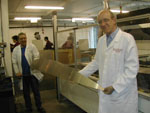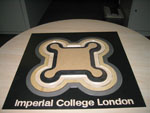27 April 2009
Imperial College ? a first with lasers in South Kensington
 The Faculty of Engineering at Imperial College London has greatly extended the manufacturing facilities available to its undergraduates and researchers by investing in a laser profiler. The pre-owned 1.5Kw LVD Helius was supplied, to a tight time schedule, by Rugby based Manufacturing Service Solutions (MSS), specialists in laser cutting machinery and nitrogen generation plants.
The Faculty of Engineering at Imperial College London has greatly extended the manufacturing facilities available to its undergraduates and researchers by investing in a laser profiler. The pre-owned 1.5Kw LVD Helius was supplied, to a tight time schedule, by Rugby based Manufacturing Service Solutions (MSS), specialists in laser cutting machinery and nitrogen generation plants.
According to the 2008 Times Higher Education Supplement World University Rankings for Engineering, the Imperial College Faculty is ranked 7th in the world and 2nd in Europe. It comprises nine departments including the Institute of Biomedical Engineering, the Energy Futures Lab, 5,000 students, 1,200 staff, and is one of the largest engineering faculties in the UK.
Graham Gosling, Design & Technical Manager, Department of Mechanical Engineering, says, “We have an internal market for our manufacturing processes which include CNC milling and turning, rapid prototyping, hard metal machining and fabrication. For profiling sheet metalwork we only had a punch press, the improved accuracy and new capabilities of laser cutting will be a significant addition.”
 Year 1 and 2 undergraduates learn basic workshop skills, while years 3 and 4 carry out project work. Overall, the department provides practical support for around 100 projects each year.
Year 1 and 2 undergraduates learn basic workshop skills, while years 3 and 4 carry out project work. Overall, the department provides practical support for around 100 projects each year.
The installation of the laser provides much greater scope for innovation and originality in the students’ and researchers’ work, enabling them to produce forms which would previously have been virtually impossible or too time consuming to achieve.
Installation and commissioning of the machine was to a tight time schedule. MSS delivered the machine on the first day after the Christmas break, and fitted the set-up and training around the Department’s demanding teaching schedule.
Designs are produced in Solid Works and transferred as .dxf files to the Lantek CAD/CAM system which produces the profiling path for the laser. Graham adds: “MSS was very efficient and flexible, providing us with the resources to enable us to be self sufficient as quickly as possible.”
The LVD is already being used to manufacture the multiple wing spar templates for the Imperial College entry in the June 2009 Red Bull Flugtag where competitors aim to achieve man powered flight. Graham says, “The laser has enabled us to produce a continually changing wing profile, which should provide much better performance and lift this year. I have always been a fan of the speed, accuracy and flexibility of laser technology. Not only will it enable us to produce more sophisticated and precise metal parts, but we anticipate that we will soon be cutting other materials such as Perspex and MDF once we have improved the extraction. ”
 The machine will be invaluable in the Formula Student competition. This is run by the Institute of Mechanical Engineers and its aim is to produce a prototype single seat racing car whose design incorporates aesthetic, cost and performance factors. So far the laser has been used to produce a pedal box, but it is anticipated that bodywork, fascia panels, and many other sheet metal components will benefit from the new technology. Supported by outside sponsorship, the college is building two cars powered by BMW motorbike engines. Graham says, “The LVD is crucial to this project, as there is a considerable amount of precision metalwork involved. Previously, we would have had to subcontract this work or use unnecessarily complicated fabrication methods.”
The machine will be invaluable in the Formula Student competition. This is run by the Institute of Mechanical Engineers and its aim is to produce a prototype single seat racing car whose design incorporates aesthetic, cost and performance factors. So far the laser has been used to produce a pedal box, but it is anticipated that bodywork, fascia panels, and many other sheet metal components will benefit from the new technology. Supported by outside sponsorship, the college is building two cars powered by BMW motorbike engines. Graham says, “The LVD is crucial to this project, as there is a considerable amount of precision metalwork involved. Previously, we would have had to subcontract this work or use unnecessarily complicated fabrication methods.”
Interest in the new technology is now coming from all over the campus, ranging from mundane tasks such as cutting ‘dog bone’ test pieces for tensile testing experiments, to conceptual car design projects through Imperial College’s links with the Royal College of Art. Graham concludes, “The technology is inspirational for students who are continually asking for time on the machine. It is probably the most significant piece of equipment purchased by the workshop over the last 20 years.”
- Contact Information
- Name: Carlos Gonzalez-Lee
- Email: carlos@mss-lasers.com

